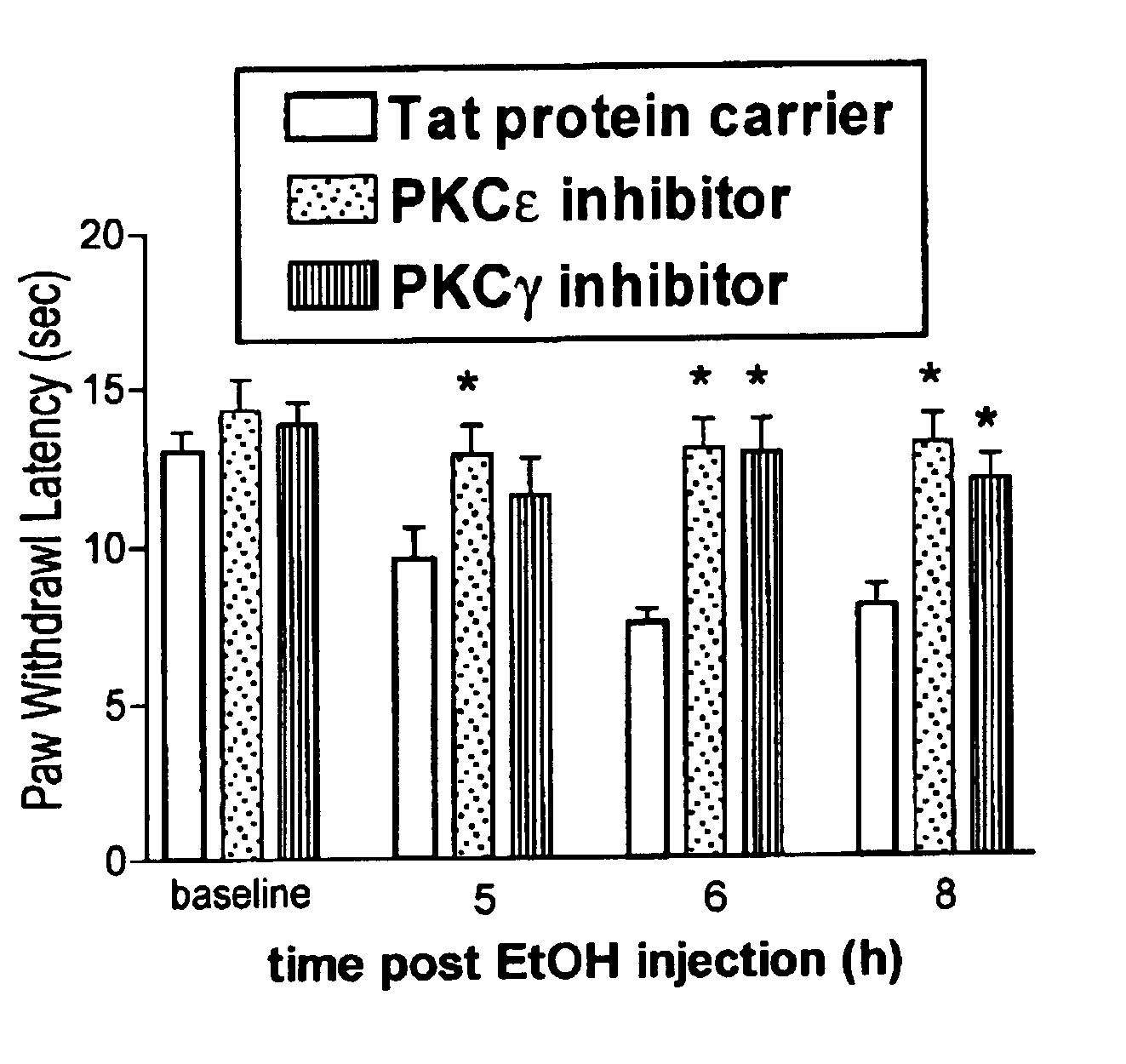Protein kinase C peptides for use in withdrawal
a technology of kinase c and peptides, which is applied in the direction of peptide/protein ingredients, peptide sources, metabolic disorders, etc., can solve the problems of addiction, difficult withdrawal from habit-forming drugs, and detrimental effect on addicted individuals, so as to reduce dependence on addictive drugs
- Summary
- Abstract
- Description
- Claims
- Application Information
AI Technical Summary
Benefits of technology
Problems solved by technology
Method used
Image
Examples
example 1
In Vitro Measurement of sVRP
[0134]Spinal cords from 4-7 day old rats (Charles River Laboratories) were removed and arranged for electrophysiological recording of the slow ventral root potentials (sVRP) (Woodley S. J., et al., Brain Res., 559: 17-21 (1991). Briefly, pups were decapitated under halothane anesthesia and the spinal cord removed to an oxygenated artificial cerebrospinal fluid solution. A suction stimulating electrode was placed on a lumbar dorsal root and a suction recording electrode on the corresponding ipsilateral ventral root. Square wave stimuli 0.2 ms in duration were administered at a constant frequency of 1 / 50 seconds throughout the experiment. Test agents were applied and the responses were recorded, digitized, and area under the curve measured.
[0135]After a baseline reading of the sVRP, morphine (200 nM) was applied to the isolated spinal cords. The sVRP was again recorded to characterize the response to morphine. Naloxone (200 nM) was then applied and the sVRP...
example 2
In vivo Mechanical Threshold and Thermal Paw Withdrawal Studies
[0138]Postnatal day 7 Sprague-Dawley rats (Charles River Laboratories) of both sexes were used. For all behavioural experiments rats were maintained at nesting temperature with overhead heatlamps.
[0139]To measure mechanical thresholds, rats were placed on an elevated wire mesh (2 mm openings). Von Frey hairs (Stoelting Co., WoodDale, Ill., USA) were used to elicit a cutaneous flexion withdrawal response as described by Fitzgerald et al. (Fitzgerald M., et al., PAIN MANAGEMENT IN INFANTS, CHILDREN AND ADOLESCENTS; Schetchter and Yaster, Eds., pp 11-32, Williams and Williams (Baltimore, Md.) (1993). Von Frey hairs of increasing intensity were applied three times to the plantar surface of the left hind paw until a paw withdrawal was elicited. The lowest intensity Von Frey hair required to produce a withdrawal reflex was recorded as the response threshold to a low-intensity mechanical stimulus.
[0140]Thermal paw withdrawal la...
example 3
Effect of γPKC Peptides on Alcohol Withdrawal Hyperresponsiveness In vitro
[0144]Sprague-Dawley rats at postnatal day 7-10 were anesthetized with halothane, decapitated, and the spinal cords were quickly removed. Slices 350 mm thick were sectioned from the lumbar region. Whole cell voltage clamp recordings were made from visually-identified motor neurons using infrared video microscopy, a 60× water immersion lens, and a MultiClamp 700A patch clamp amplifier. Cells were held at a holding potential of −60 mV in artificial cerebrospinal fluid (ACSF) containing bicuculline methiodide (10 mM), strychnine (5 mM), and tetrodotoxin (0.5 mM). Postsynaptic currents were evoked by direct pressure application of 2 mM N-methyl-D-aspartate (NMDA) from a pipette positioned near the recorded cell at 1-2 min intervals, as illustrated in FIG. 7A. The area of evoked currents during and following 100 mM ethanol (EtOH) application was measured and normalized to the average baseline current area during th...
PUM
| Property | Measurement | Unit |
|---|---|---|
| time | aaaaa | aaaaa |
| volumes | aaaaa | aaaaa |
| thick | aaaaa | aaaaa |
Abstract
Description
Claims
Application Information
 Login to View More
Login to View More - R&D
- Intellectual Property
- Life Sciences
- Materials
- Tech Scout
- Unparalleled Data Quality
- Higher Quality Content
- 60% Fewer Hallucinations
Browse by: Latest US Patents, China's latest patents, Technical Efficacy Thesaurus, Application Domain, Technology Topic, Popular Technical Reports.
© 2025 PatSnap. All rights reserved.Legal|Privacy policy|Modern Slavery Act Transparency Statement|Sitemap|About US| Contact US: help@patsnap.com



